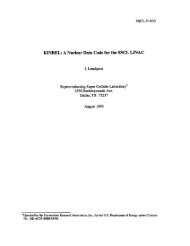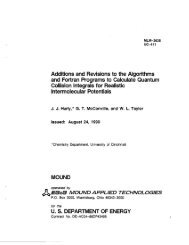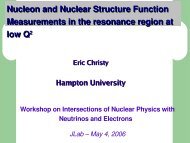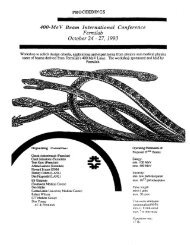Workbook
Workbook
Workbook
Create successful ePaper yourself
Turn your PDF publications into a flip-book with our unique Google optimized e-Paper software.
126<br />
It should be noted that the open geometry of the E-799 detector, the high<br />
acceptances for multi-body final states, and the high energy of the decaying<br />
kaons, leads to unprecedented sensitivities to numerous rare and not so rare<br />
kaon and neutral pion decays. We produced many new physics results from<br />
the E-799I data.<br />
R&D and preparation for KTeV: E-799II<br />
We will be using the same technique with a substantially improved<br />
detector and new beamline to reach a sensitivity for 4-body decays of 10- 11 . The<br />
most important detector upgrade will be the new pure CsI electromagnetic<br />
calorimeter. The same detector will be used for 21t E'/E studies (E-832). This<br />
program is named 'KTeV' and was approved in February 1992. A<br />
comprehensive design report on the KTeV program was produced in April<br />
1992 outlining the physics goals, the beam, the siting, and the detector in much<br />
detail. This KTeV report also describes the full details of the calorimeter<br />
material tests and thus its justification for various parameters.<br />
The construction of the new experimental hall began in early 1994. We<br />
have decided to use the "digital photomultiplier" for the calorimeter after<br />
many studies and tests with the prototypes. Other major detector elements<br />
include a very hermetic scintillation fiber photon veto, a multi-module<br />
Transition Radiation Detector for independent pion/electron identification, and<br />
a very high speed, high throughput data acquisition system.
















